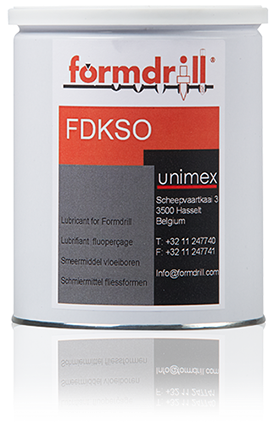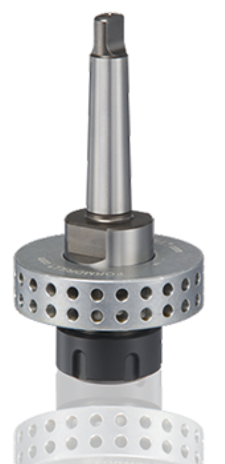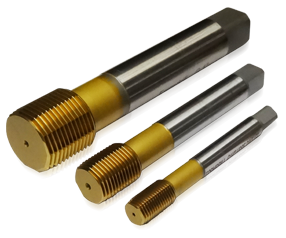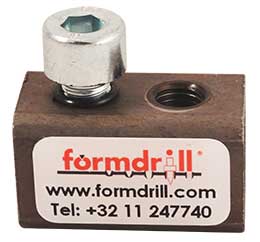
_FAQ




Frequently asked questions
Questions and answers to some common queries about our product.

1 Which materials are suited?
- Steel upto 1100N/mm²
- Stainless Steel
- Copper
- Brass (max. 40% Zinc)
- Aluminium with less then 0.5%Si
- Most "exotic" alloys
2 What do I need for 1/4-20UNC in 0.080" wall thickness?
Required tools:
- FDMC2-TOOLHOLDER
- FD430E8-COLLET
- FD0570S-FORMDRILL
- FT1/4UNC-FORMTAP 1/4-20 UNC
- FDKSO-LUBRICANT FORMDRILL
- FTOIL-LUBRICANT FORMTAP
- REMARK: FOR A FLAT SURFACE USE A FD0570SF FLAT STYLE FORMDRILL
Machine parameters:
- Spindle speed: 2800Rpm.
- Motor power: 1.5Hp.
Check out our wizard page for more information about this and any other application.
3 What is the tool life of a Formdrill?
Tool life of a Formdrill is between 8,000 to 10,000 cycles in mild steel.
Tool life of a Formdrill is between 3,000 to 5,000 cycles in stainless steel.
4 Do I need special machinery?
No, Formdrill will work on any drill press with the appropriate spindle speed and motor power. CNC-machines, milling machines or drill heads are suitable for the process.
5 Is there any lubrication necessary?
Yes, lubrication prevents the metal from welding to the tool. It increases signifantly the tool life of both Formdrill and Formtap. Lubricating every 4 to 5 holes is sufficient in steel. In stainless steel we recommend strongly to lubricate every hole. Important: Never use conventional lubricants or cooling fluids for drilling or tapping.
6 Can Formdrill be used in a hand drill?
Our advise is no. The problem with a hand drill is lack of stability and axial force. It can only work for small diameters in very thin work pieces.
7 What about galvanized material?
It depends the thickness and quality of the zinc layer. When very thin (3-5 micron) Formdrill will work. We advise a test in our lab.
8 Can I get a hole without the top collar?
The top collar is the result of material being drawn upward during the initial stage of the process. A Flat-style Formdrill is available which will remove the top collar at the same time the bushing is formed.
9 Can I drill into solid material?
No, We need clearance on the back side of the work piece. As we are displacing the parent material we need room for the material to flow.
10 Where does the insert come from?
The bushing (insert) is formed from the parent material. There are no additional components required or no material is added.
11 How strong are the formed threads?
Independent studies have showed that in most applications, thread strenght exceeds industry standards both in pull out and torque.
Formdrill Test results
5.250
8.750
8.500
11.400
14.200
12.000
16.000
24.000
22.000
36.500
43.000
46.000
69.500
50.500
84.000
84.000
94.000
94.000
126.000
122.000
147.000
196.000
5.250
8.280
9.550
12.250
14.940
13.400
17.350
+24.000
26.000
40.000
+45.000
51.700
69.800
66.000
86.800
97.000
94.220
107.300
134.400
136.000
151.800
+200.000
5.0
9.0
8.0
11.0
13.0
16.0
20.0
26.0
28.0
51.0
65.0
64.0
96.0
134.0
161.0
267.0
-
-
-
-
-
-
6
8
6
8
10
6
8
12
8
10
12
8
12
6
10
10
6
6
8
5
6
8
1.0
2.0
1.0
1.5
2.0
1.5
2.0
3.0
2.0
3.0
4.0
3.0
4.0
3.0
4.0
5.0
3.0
4.0
5.0
3.0
4.0
5.0
M4
M4
M5
M5
M5
M6
M6
M6
M8
M8
M8
M10
M10
M12
M12
M12
M16
M16
M16
M20
M20
M20
Wall
thickness
in mm
Thread size
DIN
Weld nuts
Pull out force in N
Formdrill
Results
Pull out force in N
Torque
in Nm
Class
12 Can I use a normal machine tap (cutting tap)?
Yes but we advise not to. The Formdrill system preserves the parent material to produce the threads. Using a machine tap would remove part of the formed bushing. If a machine tap is used we advise to use a Long or Long/Flat Formdrill.
13 Doesn't the material get work hardened?
This depends on the material and carbon content. In steel alloys there is almost never a problem. Stainless steel may harden about 10-15%, this causes no problem for the tapping afterwards.
14 Where does the heat come from?
All heat is generated through friction. There is no additional heat source.
15 What is the maximum material thickness?
This depends on the Formdrill diameter and style. For the larger diameters the wall thickness can go upto 0.500".
Maximum Wall Thickness
1.5
1.5
2.0
2.0
2.5
2.5
3.0
3.0
3.0
3.0
3.0
3.5
3.5
3.5
3.5
4.0
4.0
4.0
4.0
4.0
4.0
4.0
4.0
4.0
2.0
2.0
2.5
2.5
3.0
3.0
3.5
3.5
3.5
3.5
3.5
4.0
4.0
4.5
4.5
5.0
5.0
5.0
5.0
5.0
5.0
5.0
5.0
5.0
2.5
2.5
2.5
3.0
3.5
4.0
4.5
5.0
6.0
6.0
6.0
6.0
6.0
7.0
7.0
8.0
8.0
10.0
10.0
10.0
10.0
10.0
10.0
10.0
3.0
4.0
4.0
4.0
5.0
6.0
6.0
6.0
7.0
7.0
7.0
7.0
7.0
8.5
8.5
10.0
10.0
12.0
12.0
12.0
12.0
12.0
12.0
12.0
0.06
0.06
0.08
0.08
0.10
0.10
0.12
0.12
0.12
0.12
0.12
0.14
0.14
0.14
0.16
0.16
0.16
0.16
0.16
0.16
0.16
0.16
0.16
0.16
0.08
0.08
0.10
0.10
0.12
0.12
0.16
0.16
0.16
0.16
0.16
0.18
0.18
0.18
0.20
0.20
0.20
0.20
0.20
0.20
0.20
0.20
0.20
0.20
0.10
0.10
0.10
0.12
0.14
0.16
0.18
0.20
0.24
0.24
0.24
0.24
0.24
0.28
0.28
0.32
0.32
0.40
0.40
0.40
0.40
0.40
0.40
0.40
0.12
0.16
0.16
0.16
0.20
0.24
0.24
0.24
0.28
0.28
0.28
0.28
0.28
0.34
0.34
0.40
0.40
0.47
0.48
0.48
0.48
0.48
0.48
0.48
2.0 – 2.9
3.0 – 3.9
4.0 – 4.9
5.0 – 5.9
6.0 – 6.9
7.0 – 7.9
8.0 – 8.9
9.0 – 9.9
10.0 – 10.9
11.0 – 11.9
12.0 – 12.9
13.0 – 13.9
14.0 – 14.9
15.0 – 15.9
16.0 – 16.9
17.0 – 17.9
18.0 – 18.9
19.0 – 19.9
20.0 – 20.9
21.0 – 21.9
22.0 – 22.9
23.0 – 23.9
24.0 – 24.9
25.0 – 25.9
SHORT
mm
mm
mm
mm
inches
inches
inches
inches
Formdrill
diameter
(mm)
SHORT/FLAT
LONG
LONG/FLAT
16 Can a three-jaw chuck be used to clamp the Formdrill tool?
No. You risk the Formdrill to break. A collet type chuck is advised.
You also can overheat the machine spindle.17 When do I need a short or long tool?
Tool length depends on the material thickness you work with. Careful: Tool should be short enough not to penetrate the opposite. Every Formdrill tool has a cylindrical and a conical part. The cylindrical part is responsible for forming the bushing diameter. The hole should be slightly tapered before tapping to ensure well formed thread over the complete length of the Formdrill bushing. If the bushing is too tapered it may cause problems during the tapping operation, in that case you should use a Long Formdrill tool.
18 What material is the Formdrill tool made of?
The Formdrill tool is made of special sintered carbide.
The material is then grinded to a Formdrill friction drilling tool.19 Do I need to use different Formdrill tools for different materials?
Usually not. However, depending on the material quality and requirements for the threads an adjustment of the diameter may be necessary.
20 Are the thread formed in the same step?
No, Threads are formed in a secondary operation or with self -tapping screws.
21 The Formdrill tool gets red during the process, is this dangerous?
No, Formdrill tools can develop temperatures of up to 1475°F and begin to glow dark red.
When the Formdrill tool turns bright red or yellow it is getting too hot.
This reduces tool life, machine parameters should be optimised.22 How can I reduce the material that runs inward?
We advise to pre-drill a pilot hole before the Formdrill process. With the predrilled hole the bushing length will be reduced. Smoother edges of the bushing can also be achieved this way.
Request
Sample piece_
Cancel
Contact me_
Cancel
Request
Literature_
Cancel

_Info
_Literature
_Sample piece
Click on the "Contact me" button
so we can discuss your application.
Click to receive our literature.
Click on "Sample" button
to get your sample cube.

Sample
Contact me
Literature







